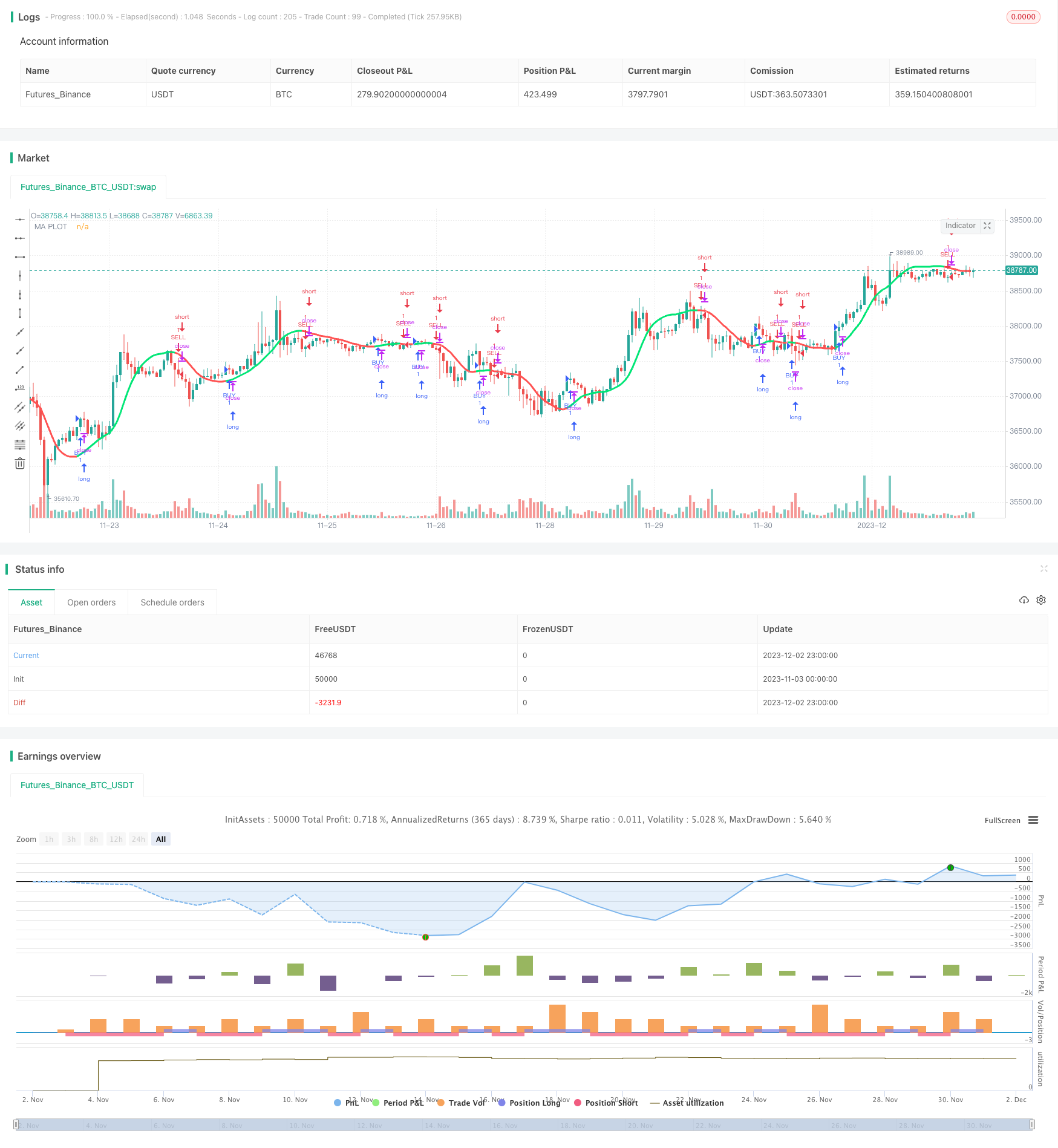
概述
这是一个基于双重移动平均线指标的反转交易策略。该策略通过计算两组不同参数设置的移动平均线,根据其方向变化来判断价格趋势,并设定方向变化的灵敏度参数,从而产生交易信号。
策略原理
该策略的核心指标是双重移动平均线。策略允许选择移动平均线的类型(SMA、EMA等)、长度和价格源(收盘价、典型价格等)。计算出两组移动平均线之后,通过定义参数reaction判断其方向。当快线上穿慢线时产生买入信号,下穿时产生卖出信号。reaction参数用来调整识别转折点的灵敏度。
此外,策略还设定了变化方向和持续上涨/下跌的条件判定,避免产生错误信号。并用不同颜色可视化表示价格的涨跌状态。当价格持续上涨时,movavg线显示为绿色,下跌时为红色。
优势分析
这种双重movavg策略结合不同参数设定的快慢线,可以有效滤波交易市场的噪声,识别较强势的趋势。相比单一movavg策略,它减少了错误信号,可以在趋势更加明确时入场,从而获得更高的胜率。
灵敏度参数reaction让该策略可以灵活适应不同周期和品种。策略过程直观简单,容易理解和优化。
风险分析
该策略最大的风险在于错过转折点而亏损或反向建仓。这与参数reaction设定有关。如果reaction太小,则容易产生错误信号;如果reaction太大,则可能错过较好的入场点。
另一个风险是无法有效控制亏损。当价格出现剧烈波动时,无法快速止损,导致亏损扩大。这需要配合止损策略来控制。
优化方向
该策略的优化方向主要集中在参数reaction、移动平均线类型及长度的选择。reaction可适当增加来减少错误信号。移动平均线参数可据不同周期和品种进行测试,选择产生信号最佳的组合。
另外,结合其他辅助指标如RSI、KD等来确认交易信号也是优化思路。或使用机器学习方法自动优选参数。
总结
本策略整体来说较简单实用,通过双重移动平均线滤波并产生交易信号,可有效识别趋势反转,是一种典型的趋势跟踪策略。优化参数组合后,其顺市捕捉能力和抗市持仓能力都会得到提高。与止损和位置管理机制配合使用效果更佳。
/*backtest
start: 2023-11-03 00:00:00
end: 2023-12-03 00:00:00
period: 1h
basePeriod: 15m
exchanges: [{"eid":"Futures_Binance","currency":"BTC_USDT"}]
*/
//@version=3
strategy(shorttitle="MA_color strategy", title="Moving Average Color", overlay=true)
// === INPUTS
ma_type = input(defval="HullMA", title="MA Type: ", options=["SMA", "EMA", "WMA", "VWMA", "SMMA", "DEMA", "TEMA", "HullMA", "ZEMA", "TMA", "SSMA"])
ma_len = input(defval=32, title="MA Lenght", minval=1)
ma_src = input(close, title="MA Source")
reaction = input(defval=2, title="MA Reaction", minval=1)
// SuperSmoother filter
// © 2013 John F. Ehlers
variant_supersmoother(src,len) =>
a1 = exp(-1.414*3.14159 / len)
b1 = 2*a1*cos(1.414*3.14159 / len)
c2 = b1
c3 = (-a1)*a1
c1 = 1 - c2 - c3
v9 = 0.0
v9 := c1*(src + nz(src[1])) / 2 + c2*nz(v9[1]) + c3*nz(v9[2])
v9
variant_smoothed(src,len) =>
v5 = 0.0
v5 := na(v5[1]) ? sma(src, len) : (v5[1] * (len - 1) + src) / len
v5
variant_zerolagema(src,len) =>
ema1 = ema(src, len)
ema2 = ema(ema1, len)
v10 = ema1+(ema1-ema2)
v10
variant_doubleema(src,len) =>
v2 = ema(src, len)
v6 = 2 * v2 - ema(v2, len)
v6
variant_tripleema(src,len) =>
v2 = ema(src, len)
v7 = 3 * (v2 - ema(v2, len)) + ema(ema(v2, len), len)
v7
variant(type, src, len) =>
type=="EMA" ? ema(src,len) :
type=="WMA" ? wma(src,len):
type=="VWMA" ? vwma(src,len) :
type=="SMMA" ? variant_smoothed(src,len) :
type=="DEMA" ? variant_doubleema(src,len):
type=="TEMA" ? variant_tripleema(src,len):
type=="HullMA"? wma(2 * wma(src, len / 2) - wma(src, len), round(sqrt(len))) :
type=="SSMA" ? variant_supersmoother(src,len) :
type=="ZEMA" ? variant_zerolagema(src,len) :
type=="TMA" ? sma(sma(src,len),len) : sma(src,len)
// === Moving Average
ma_series = variant(ma_type,ma_src,ma_len)
direction = 0
direction := rising(ma_series,reaction) ? 1 : falling(ma_series,reaction) ? -1 : nz(direction[1])
change_direction= change(direction,1)
change_direction1= change(direction,1)
pcol = direction>0 ? lime : direction<0 ? red : na
plot(ma_series, color=pcol,style=line,join=true,linewidth=3,transp=10,title="MA PLOT")
/////// Alerts ///////
alertcondition(change_direction,title="Change Direction MA",message="Change Direction MA")
longCondition = direction>0
shortCondition = direction<0
if (longCondition)
strategy.entry("BUY", strategy.long)
if (shortCondition)
strategy.entry("SELL", strategy.short)